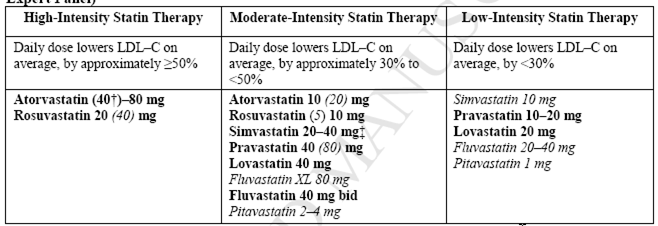Statin Use for the Primary Prevention of Cardiovascular Disease in Adults: Preventive Medication
(If the patient has ASCVD they are candidates for moderate-to-high-dose statin therapy)
Recommendations made by the USPSTF are independent of the U.S. government.
They should not be construed as an official position of the Agency for Healthcare Research and Quality or the U.S. Department of Health and Human Services.
Population Adults aged 40–75 y with no history of CVD, ≥1 CVD risk factors, and calculated 10-y CVD event risk of ≥10% Adults aged 40–75 y with no history of CVD, ≥1 CVD risk factors, and calculated 10-y CVD event risk of 7.5%–10% Adults 76 y and older with no
history of CVDRecommendation Initiate use of low- to moderate-dose statins.
Grade: BDiscuss with patient and selectively offer use of low- to moderate-dose statins.
Grade: CNo recommendation.
Grade: I (insufficient evidence)Risk Assessment Risk factors for CVD include dyslipidemia (LDL-C >130 mg/dL or HDL-C <40 mg/dL), diabetes, hypertension, and smoking. The USPSTF recommends using the ACC/AHA Pooled Cohort Equations to calculate 10-y risk of CVD events. Preventive Medication Statins are a class of lipid-lowering medications that function by inhibiting the enzyme 3-hydroxy-3-methyl-glutaryl coenzyme A reductase. Statins reduce levels of total cholesterol and LDL-C and, to a lesser extent, triglycerides. The most directly applicable body of evidence for patients without a history of CVD demonstrates benefits with use of low- to moderate-dose statins. Considerations for Implementation The likelihood that a patient will benefit from statin use depends on his or her absolute baseline risk of having a future CVD event, a risk estimation that is imprecise based on the currently available risk estimation tools. Thus, clinicians should discuss with patients the potential risk of having a CVD event and the expected benefits and harms of statin use. Balance of Benefits and Harms The USPSTF concludes with moderate certainty that initiating use of low- to moderate-dose statins in this population has at least a moderate net benefit. The USPSTF concludes with moderate certainty that initiating use of low- to moderate-dose statins in this population has a small net benefit. The USPSTF concludes that the evidence is insufficient to determine the balance of benefits and harms of initiating statin use in this population. Other Relevant USPSTF Recommendations The USPSTF has made other recommendations relevant to the prevention of CVD in adults, including aspirin use for the prevention of CVD, screening for coronary heart disease using electrocardiography, use of nontraditional risk factors in CVD risk assessment, screening for high blood pressure, screening for abnormal blood glucose and type 2 diabetes mellitus, interventions for tobacco smoking cessation, behavioral counseling to promote a healthful diet and physical activity for CVD prevention in adults, and screening for and management of obesity in adults. These recommendations are available on the USPSTF website (https://www.uspreventiveservicestaskforce.org). Abbreviations: ACC/AHA=American College of Cardiology/American Heart Association; CVD=cardiovascular disease; LDL-C=low-density lipoprotein cholesterol; HDL-C=high-density lipoprotein cholesterol; USPSTF=US Preventive Services Task Force.
For a summary of the evidence systematically reviewed in making this recommendation, the full recommendation statement, and supporting documents, please go to www.uspreventiveservicestaskforce.org. Current as of: November 2016
Internet Citation: Clinical
Summary: Statin Use for the Primary Prevention of Cardiovascular
Disease in Adults: Preventive Medication. U.S. Preventive
Services Task Force. November 2016.
https://www.uspreventiveservicestaskforce.org/Page/Document/ClinicalSummaryFinal/statin-use-in-adults-preventive-medication1
